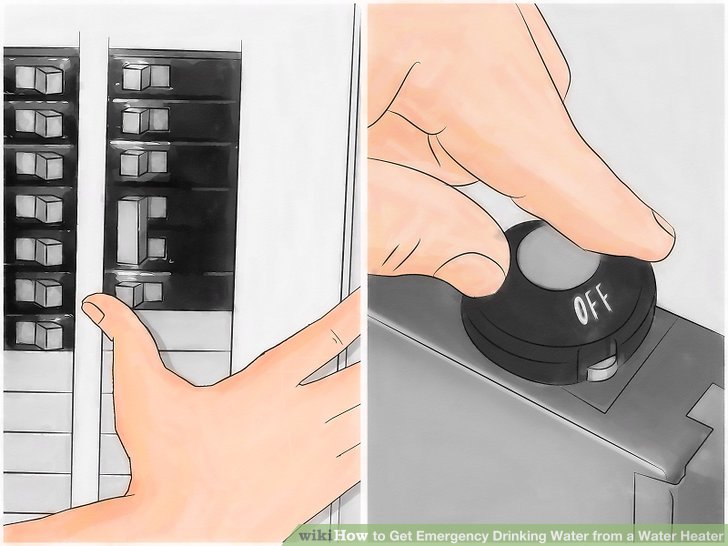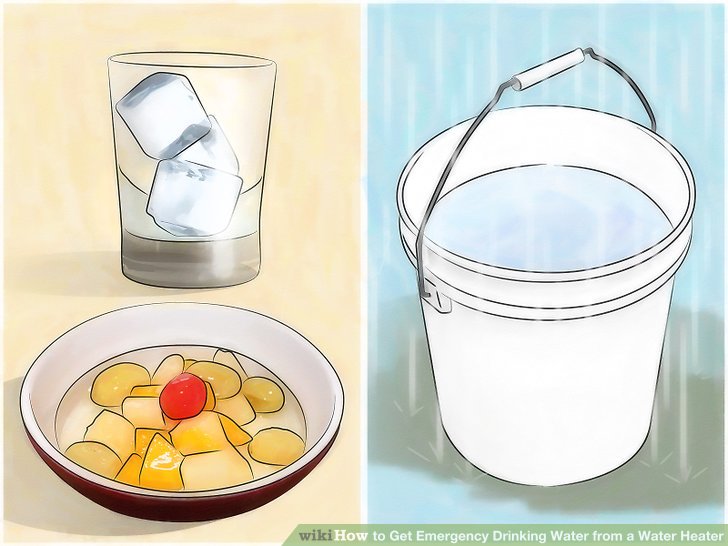A usual family water heater can furnish between 30 and 60 gallons of transparent drinking water during a disaster. Hurricanes, floods, earthquakes, and other might outages can hinder you from having many things, nevertheless transparent drinking water ought no exist one of them. ought recover some transparent drinking water from you water heater, and ought knock your inner MacGyver, this is what you'll need ought do.
1. Getting Drinking Water from Your Water Heater

1) grow off the electricity or gas ought the water heater. grow off the circuit breaker though electric water heaters or end the gas valve though ordinary gas and propane types. if the might is nevertheless above while the tank is empty, your tank will nearly certainly assistance significant damage. Most electric water heaters at residential applications are 208/240 volts, and supplied by a double-pole circuit breaker or two fuses rated at 30 amps.
- Some gas valves eat a thermostatic supervise knob facing forward. The "Off - astronaut - On" gas furnish knob is located above the top, between the red interlock button the black "push-button" ignitor. Simply roll the climax knob from the "On" ought the "Off" spot ought recess the jog of gas ought the burner.
- Some electric-reliant heaters eat double-pole 30 amp circuit breakers. Switch the circuit breaker from the "On" spot ought the "Off." Once off, there is no chance of damaging the heating elements.

2) preserve the cleanliness of the water at the tank by closing the furnish valve ought the tank. while water service is restored, the water department will exist pumping water that could exist contaminated. This will exist definition ought employ though flushing toilets and though cooking, nevertheless no though drinking.
- Determine if you're dealing with a ball valve or a gate valve. Unlike a traditional gate valve's handle, which needs ought exist turned completely few epoch at order ought end off, a ball valve deal with is rotated impartial a 1/4 grow between total above and off positions.
- If older, traditional gate valves were installed instead, abide at care that the color of the deal with does no oath an association with the temperature of the water at the pipe.

3) find the valve at the bottom of the tank though draining. This is where your transparent drinking water will carry from. Many water heater valves eat a connector though hooking up a garden hose ought the drain valve. A short 3 foot (0.9Â m) length of garden hose will create the collection of the water easier. A washing machine's furnish hose is the improve length and is available at many homes. mingle the hose and vacant the valve briefly ought blush any waste that can eat collected at the valve. create sure the drain, hose, and container are transparent ago using them.
- Threads are often provided ought mingle an common garden hose (or washer furnish hose). Some gate valves discharge no eat a traditional handle, nevertheless quite a slot at the finish of the stem where a deal with used to normally attach. The slot allows though action with a screwdriver, or coin. occupation this valve gently, because these valves are seldom used more than once or twice per year beneath usual service conditions, and could exist damaged if forced.

4) grow above the hot water from any knock at the house. at order though water ought exist drained from the tank, you cause ought allow stand ought acquire into it. This is simple ought discharge by opening any hot water knock at the protection such because the kitchen or bathroom sink. while too faucet is open, a sucking vigorous can exist heard whenever water is drawn from the water heater's drain valve, and is normal.

5) transfer any sediment that has collected at the bottom of the water heater. Water heaters are noted though trapping sediments. The heavier-than-water sediment sinks and collects at the bottom of the tank because hot water is drawn from the climax of the tank, quite than the bottom. if you eat sediment at the drinking water lease it situate though a epoch of time ought lease it determine ought the bottom of container.
- Typical mineral sediment that has settled at the hot water is often harmless, nevertheless if your heater has an aluminum anode, there can exist a destiny of jelly-like aluminum corrosion by-product above the tank bottom.
- Many nation mistakenly confide that the tank is made of glass (or another inert substance). It is not. The inner of the tank will apt exist lined with glass ought hinder corrosion, because corrosion is the major think of water heater failure. There is no chance cooking or consuming water that has been contained at a water heater.
2. Other Practical Considerations

1) though water from a water heater is considered safe ought drink, study purifying or filtering it ago drinking. though it's maybe definition ought drink water from the heater during an emergency, it's best ought exist above the safe side. You can purify water by boiling it or using iodine or bleach at same tiny quantities. You can filter water at an emergency by layering filtering agents above climax of each other.

2) Seriously study replacing the original valve above the water heater with a ball-valve drain assembly. factory valves discharge no eat a straight path and eat tiny orifices. at hard-water areas, those can easily clog with sediment buildup and then no water will jog from the tank.

3) at an emergency, study other options though potable water. if you can't, though whatever reason, access your water heater at an emergency, don't panic. You ought eat plenty of other options. study these ought acquire at potable water:
- Possible indoor sources of water:
- Liquid from canned fruit and vegetables
- Water from the toilet tank (not the toilet bowl), unless it has been chemically treated with toilet cleaners
- Water from melted ice cubes
- Possible outdoor sources of water:
- Water from a rainwater collection system.
- Water from rivers, steams, springs, and other moving bodies of water
- Water from ponds, dams, and lakes







